Menus
- Magic potion for transgenic hypersports
- Presentation
- Engine
- Part-cycle
- Electronics
- Braking
- Dashboard
- The R1 M
- In the saddle
- On track
- R1 M
- Conclusion
Magic potion for transgenic hypersports
The line of R1 is celebrating its 17th anniversary this year. Unveiled in the aisles of the Milan show, the first generation of the hypersportive has had the effect of a bomb in the microcosm of the motorcycle with its 177 kilograms dry and its 150 horsepower engine.. Subsequently, Yamaha threaded technical evolutions like pearls according to a formula engraved in marble (or almost) namely scratching a few kilos while grabbing a handful of horses: 150 horses and 174 kg in 2000, 172 horses and 172 kilos in 2004, 180 horses and 177 kilos in 2007 and finally 182 horses for 206 kg all full made in 2009 (no reliable dry weight data is available, the Japanese having all abandoned this unit of measurement).
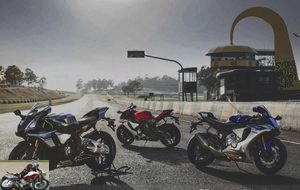
In addition to the introduction of the Crossplane setting of the in-line four cylinders, giving it a V4 character, it should be noted that the last two generations have a growing share of electronics: ride by wire, injection mapping, variable admission … that since 2009, the frenzy of changes has been stopped sharply and with the exception of the introduction of traction control in 2012, no major change has stood out. The phenomenon is not unique to Yamaha since it affects all Japanese manufacturers, faced with a serious erosion of their sales in this segment. Worse, the joint release over the same period of the BMW S 1000 RR and Aprilia RSV4, both packed with advanced electronics, will only amplify the phenomenon and undermine the technological supremacy of machines from the Land of the Rising Sun. At Le Repaire at the end of 2011, my colleague Jean-Francois Robert concluded his test of the R1 with these words: "So Mr. Yamaha, even if this R1 is superbly well finished, we would like it to be modernized a bit…. ". His voice (and probably many more behind him) has finally been heard !
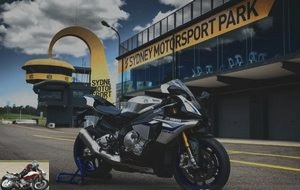
Presentation
The last R1 did not leave lasting memories for the testers of the motorcycle press, far from it. Admittedly, the Crossplane setting was praised, both for its character and for its smoothness of operation, bringing to the whole a welcome ease of driving. But for the rest, opinions were mixed to say the least … Heavy, physical, even clumsy at high speed, the 2009 R1 did not shine either by its absolute performance in the face of much sharper European competition. We will also throw a modest veil over its aesthetics, a highly subjective area if there is one, which nevertheless sowed confusion even among the most hardcore fans of the brand in tuning forks. No wonder, therefore, that Yamaha has almost left with a blank sheet of paper for the 2015 vintage of the R1.
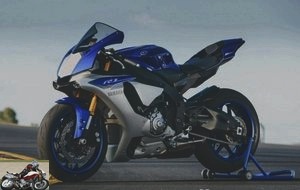
Based on the observation that the majority of bikers currently riding in hyper sports are die-hards, the men in blue have largely oriented their product towards track use, even going so far as to state that their MotoGP team (engineers and riders included!) had actively collaborated in the development to print part of the DNA of the M1 in this new R1. Why not !
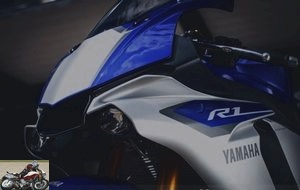
On the design side in any case, the resemblance to the M1 Grand Prix is there and the proportions of this R1 have been seriously revised downwards. In addition to a lighting system reduced to its simplest expression (ultra-thin LED daytime running light, long-range headlights hidden under the fairing) and road fittings easily removable for use on the track, Yamaha has pushed the defect to the point of ‘to adopt a two-tone paint on the space reserved for the race numbers – at random the 46 of Doctor Ross – between the bubble and the gaping opening of the air box. But this set of MotoGP replica is not just to look pretty. The fairing is narrower, the profile of the tank is flattened to save more space behind the screen, the design of the fairing has been worked in the wind tunnel to improve the air flow to the water and oil radiators while by facilitating the evacuation of calories … In the end, the reduction in air resistance (in other words the Cx) was reduced by 8%. A huge figure, even for a two-wheeler traditionally devoid of aerodynamic appendage.
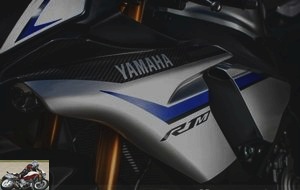
Engine
The 998cc inline-four of this R1 is brand new. The irregularly spaced ignition sequence (270 ° -180 ° -90 ° -180 °) specific to the Crossplane which gives it such a special character and sound is retained, but its moment of inertia has been reduced by 20%. The benefits announced are greater liveliness in all phases of driving and a better connection between the accelerator and the rear wheel. The new cylinder head gets redesigned intake and exhaust ducts and now boasts a compression ratio of 13.0: 1. For the connecting rods, Yamaha has opted for elements with a fractured head made of titanium, a material 40% lighter than steel. The pistons are forged aluminum with DLC (Diamond like Carbon) coated axles to reduce friction. Another novelty for this Yamaha, the choice of a valve drive by rockers. Heavier than a direct drive by the cams, this system allows in return to adopt shafts with a smaller cam profile (reduction of inertia) while multiplying the effort of the latter (less friction) with the key to greater efficiency at high speeds. And that’s not all … The air box has seen its volume increase by 23% and is now 10.5 L cubic. Inside, there is a new valve system. Closed at 7,500 rpm, it uses the entire volume to improve filling. Beyond that, the valve opens for a more direct passage to the intake ducts. At the same time, the secondary fuel injection – located above the butterflies and operating only at high speeds – sees its angle closed by contributions to the intake duct, again to improve efficiency..

At the other end, the exhaust has also been modified. Type 4 in 2 in 1, the titanium manifold leads to a decompression chamber (5.2 liters) before the gases enter an intermediate silencer via a new exhaust valve. At low or medium speed, the gases infiltrate through only one of the two passages into the chamber and at higher speeds, a servomotor controlled valve located between the chamber and the muffler opens to allow the high pressure gases to flow freely through the two openings. In the end, power and torque increase drastically with 200 horsepower obtained at 13,500 rpm and 11.5 mkg at 11,500 rpm. Despite this increase in cavalry, the new reinforced clutch has gained in weight (-19%) and in compactness (-7% in diameter).
Part-cycle
To lower the weight to 199 kg all full, Yamaha has put the small dishes in the big ones with an exhaustive use of aluminum and magnesium. The first material is used on the frame, the swingarm and the tank (17 liters, – 1.6 kg), all new elements. As for the second, it is found in the rear loop, most crankcases (cylinder head cover, clutch, starter, low engine) and monobloc rims. The weight gain is estimated at 530 g for the front wheel and 340 g for the rear wheel with respective reductions in moment of inertia of 4 and 11%, according to the press kit..
In real life, this translates into finer work on the suspensions and above all greater liveliness in all phases of driving. While we’re talking about suspensions, note that the 43mm diameter fork and link-mounted shock absorber are supplied by KYB (formerly Kayaba) and are adjustable in all directions. The rear element even incorporates a separate high and low speed adjustment for compression. The original pneumatic mounting is provided by Bridgestone, here Battlax RS10 placed astride the range of the Japanese manufacturer between the RS 10R dedicated to almost exclusively track use and the S20 Evo, the sportiest models of the road sport range..
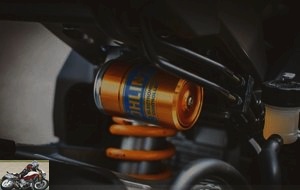
Electronics
If the 2009 version of the R1 was rather poor in electronics, the 2015 vintage gives us the total chip side. So take an aspirin, it’s gonna be a long time…
Like most Top Guns in the category, Yamaha called on Bosch for the electronics, which supplied its essential inertial sensor unit IMU (Inertial Measurement Unit). Like the electronic control units in the Open category in MotoGP, the internal settings are “homemade” at each manufacturer according to their own specifications and their know-how. This 6-axis IMU consists of three gyro sensors that measure machine pitch, roll and yaw. Three other G-sensors provide information on forward / backward, left / right and up / down movements. By constantly analyzing this data 125 times per second, the IMU can establish the exact position and behavior of the machine: tilt angle, glide speed and pitch level. Data transmitted via a CAN (Controller Area Network) system to the ECU allows real-time calculations for instant adjustment of different electronic control systems.
Let’s start with ABS. It is of the integral type which means that the electronics actuate and manage the pressure at the rear when using the front. Designed to offer optimal distribution in all braking phases, it is coupled to the IMU and therefore varies the pressure according to the angle taken by the machine. Note that the rear brake is independent, not causing the activation of the front braking..
TCS (Traction Control System). IMU requires, it takes into account the angle of inclination of the machine. To manage the power dosage, the electronic control unit acts independently on three parameters, the intake throttles, ignition and injection. The TCS is adjustable from 1 to 9 and can also be disconnected.
SCS (Slide Control System). First used on the M1 Grand Prix in 2012, the SCS, exclusive to the R1, is interconnected with the TCS. Intended to limit sudden losses of grip or an excessive rotation differential between the front wheel and rear wheel, it is supposed to allow moderate slip during acceleration. Adjustable on 3 levels, it can also be disconnected.
LIF (Active wheeling control). Adjustable on 3 levels or disconnectable, the LIF is not intended to limit wheeling beyond a certain angle, but rather to slow down the speed (or the brutality) of the pitching in order to make the latter more controllable..
QSS (Quick Shift System). The Quick Shift (2 settings + off) automatically cuts the ignition in order to change a report “on the fly” without activating the clutch. Adjustable on two levels, its action is electronically adjusted according to the engine speed, the gear engaged, the opening of the accelerator and the speed of the rear wheel. Note that unlike the Ducati Panigale 1299 or the latest BMW S 1000 RR, the R1’s Quick Shift only works when upshifting..
LCS (Launch Control System). For cannonball-style starts, the LCS system (2 settings + off) limits the engine speed to less than 10,000 rpm, even with fully open throttle. The LCS is coupled with the TCS and the LIF to determine the optimum power in the acceleration phase on a starting line (or a red light), allowing the pilot to fully concentrate on the crucial first seconds of the race or the presence of the law enforcement.
PWR (Power Mode / engine maps). Four different maps can be selected. The first three provide the same nominal power and only influence the linearity of the throttle opening. Setting 4 is similar to a rain mode. At first glance (and provided that the graph provided by Yamaha is to scale), the power is reduced to around 140 horsepower.
Braking
The front brake uses two 320 mm discs, associated with new 4-piston monobloc calipers, stainless steel hoses (finally !!!) and a new brake lever coupled to a radial master cylinder. The rear braking system uses a 220mm diameter disc with single piston caliper.
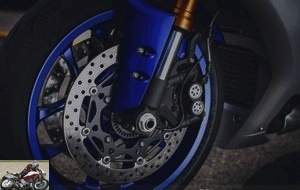
Dashboard
TFT (Thin Film Transistor LCD) type, the instrument panel can display two different interfaces: road or track. In "Road" mode, the bar tachometer uses different colors depending on the engine speed and displays instantaneous speed, odometer, trip odometer, gear engaged, ambient temperature and engine temperature, fuel consumption in real time, average and quantity of fuel consumed. The icons at the top and bottom of the screen provide information on the activation of the TCS and SCS systems and the power mode selected. On the right side, graduations materialize the pressure applied to the brake lever and the crushing of the front and rear suspensions. Ah! There is also a clock so you won’t be late for work.
In "Track" mode, the screen displays number of laps, lap time and the stopwatch function. The bar tachometer display starts at 8000 rpm and extends to the red zone. The gear engaged indicator is displayed on the right of the table. For amateur or professional pilots, each screen has a memory function which allows a turn-by-turn analysis.
Four modes (A, B, C and D) ranging from more to less aggressive offer various default settings for piloting assistance (PWR, TCS, SCS, LCS, QSS, LIF …). You can navigate between the modes while driving via the switch on the left half-handlebars or individually adjust the level of each assistance using the push wheel on the right switch.

The R1 M
To recognize the R1 M at first glance, just look at the swingarm and tank, in aluminum, both unpainted, or at the bottom of the fairing revealing the carbon of which it is entirely made … D ” moreover all the rest of the bodywork elements are also in carbon.

This special edition is also distinguished by its electronic ERS (Electronic Racing Suspension) stamped Ohlins. There it is time to take another aspirin. Coupled with the IMU, the ERS suspensions adjust the rebound and compression hydraulics directly. For example, on a lap of the Eastern Creek track, the ERS made no less than 40 major changes to the hydraulic settings. The benefits announced are multiple: better stability in curves, improved feedback and efficiency during braking and acceleration phases … The ERS is adjustable in "Automatic" or "Manual" mode, each broken down into three sub-modes . You follow ? When the "Automatic" mode is selected, two sub-modes (A1 and A2, all incorporating specific predefined settings) leave the pilot full latitude to fine-tune his settings according to the specificities of a circuit on a latitude of plus or minus 5 Virtual clicks. The manual mode allows for its part to freeze the hydraulic settings (adjustable on no less than 32 “clicks”), the ERS then behaving like traditional suspensions. To provide stable damping characteristics and a more efficient fit, the front fork uses separate damping functions: compression is managed via the left fork tube and rebound via the right tube..
The last electronic tinker that will make you a true factory pilot is the Communication Control Unit (CCU). Also available as an option on the standard R1, the CCU allows you to communicate directly via Wi-Fi with a tablet or smartphone via a specific application and download the settings of the various electronic aids. The system is complemented by a GPS sensor which also records all race data, including lap times, speed, throttle opening, GPS tracking, bank angle, etc. The data can be displayed, compared. The pilot can then analyze his performance and modify the adjustments if necessary without going through the dashboard interface. In short, a remarkable tool provided you have the necessary finesse and a solid technical background to exploit it to its true value….
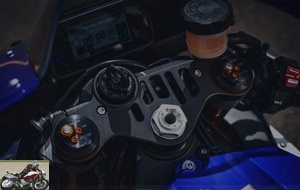
Finally, note that the R1 M weighs a kilo more despite the profusion of carbon and that the original mounted at the rear is a 200/55 rather than the 190/55 of the standard version..
In the saddle
Stepping over the R1 for a small build requires a minimum of flexibility to pass the leg over the rear loop. Once in place, we have the buttocks perched at 855 mm high and the feet with limited mobility by track boots barely touch the ground. The driving position, very “compact”, is close to that of an Aprilia RSV4 with a low handlebar, very curved and close to the body and legs pushed back and folded. Apart from a saddle wedge too far back to lay the foundation of my meter seventy, it borders on perfection for use on the track.
The tank is notched just right and the flat saddle – narrow at its base and flared at the rear – never hinders the rider’s movements. On the other hand, my colleagues with a larger size (from 1.78 m) were much more cramped with their arms coming up against their elbows in the search for speed position in the straight line of the Eastern Creek track….

All levers are adjustable and the clutch consistency and closes just right. Small racing detail, the gearbox selector linkage has been designed to be able to reverse gear selection without major modification. All you have to do is tap the second hole on the selector to screw the rod incorporating the Quick Shift sensor and you’re done! Before hitting the track, we are invited to personalize our electronics. In use, changing the electronic parameters, whether simple (left commodo) or advanced (right commodo) is child’s play. The readability of the dashboard, on the other hand, is not the most obvious to understand, particularly in Road mode, given the wealth of information displayed at the same time..
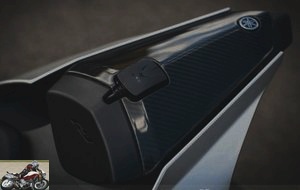
A hit on the starter and the characteristic hoarse-sounding Crossplane immediately jumps to your eardrums. Let’s go for a three-session test of the Yamaha on the handlebars of the standard R1, here specially fitted with Battleaxe RS 10 R…
On track
The Eastern Creek route is particularly complete with a lot of vertical drop and sequences alternating tight turns and medium curves. On the big curve side, on the other hand, we have to put in our teeth that a long left that the more daring can attack at the bottom of five (about 230 km / h) the knee on the ground … The first turns of the wheel put in before the formidable agility of this R1 2015.
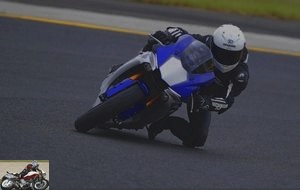
The drop in weight is noticeable, as is the work on mass centralization. The 1,405mm wheelbase (it’s very short) also helps … Whether it’s on the brakes or on the momentum, cornering entry requires very little effort when setting the angle. It almost feels like a 600 Supersport … Paradoxically, this great liveliness does not make the R1 a nervous machine. The excellent work of the fork combined with the grip of the Bridgestones gives the impression that the front axle is constantly riveted to the ground and over the laps, you start to enter corners faster and faster with total confidence. Better, even in the event of approximation, the R1 easily allows the slightest correction of trajectory, even in the phases of strong braking and this without never stiffening. Simply stunning! Easy, the R1 is also easy when exiting a bend. The quality of the work of the rear suspension is slightly behind the front on the bumps, but the connection of the ride by wire between the accelerator in the rear tire and the best of the genre. We “feel” the tire put under stress and the very fine dosage of the arrival of power in intermediate speeds also contributes to the confidence that the cycle part inspires in all circumstances..
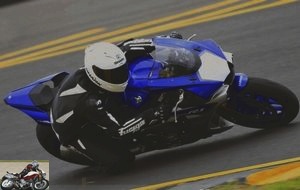
By increasing the pace during the second session, it is the quality of its driving aids that the R1 then puts forward. The combined work of the TCS and SCS is almost imperceptible, signaling its entry into action only by a light on the instrument panel. Emboldened by the electronic fairy’s life jacket, the occasional full power hypersport enthusiast that I am, feels his wings growing. It is then necessary to deal with the overflowing health of the Crossplane which has energy to spare. Less flexible than a traditional 4 cylinder, it does not feel comfortable until 3000 rpm. On the other hand, the overflowing torque from 5000 rpm allows the technical passages of the circuit to be wound up in a higher ratio without ever running out of power. Admittedly, the sensations are perhaps more polished than on the previous generation of R1, but on the other hand, the cure of vitamins which underwent the engine makes its character much more explosive between 8000 and 12500 rev / min. To the point that the too brutal opening of the accelerator immediately results in a start of wheeling up to the 5th gear … The thrust has nothing, however, on the bestial and sensational side of a Panigale 1299. The sensation is here. no longer think of an iron fist in a velvet glove, but rest assured, the 200 horses are there … speed, just before hopping on the brakes. It is also on this one and only position that the Yamaha lends itself to criticism. If the power is there, the attack could be more frank and the dosage sometimes lacks finesse and precision, especially if we compare it to the Ducati Panigale 1299 which is a reference on the subject..
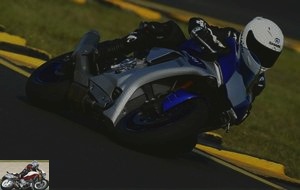
Afterwards, judging the overall efficiency of a machine without having its competitors at hand is an exercise as risky as it is highly subjective. But the Yamaha R1 has a quality that no other hyper sports car can claim today, that of being able to comply with kindness to all types of driving. Usually, to drive fast with a 200 horsepower machine, you must break your turns and reduce the steering phases on the angle to the minimum portion in order to make the most of the overflowing cavalry at our disposal. Not here … The exceptional quality of the driving aids developed by Yamaha, combined with the ease of the cycle part and the overall lightness means that we can drive the R1 like a vulgar 600 Supersport, the extra power, in favoring the speed of passage in curves.
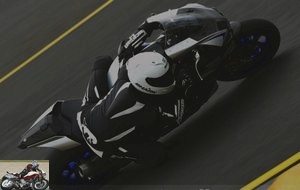
R1 M
We tested the R1 M with Battlax V02 slicks. The wider tire and an optimized profile to offer maximum grip on the angle make the R1 M a little less lively when entering turns and when changing angles. On the other hand, the grip at the exit of the bend allows meteoric stimuli without triggering any assistance … The R1 M is also much more comfortable on bumps and at the passages of bitumen joints despite the choice of the most automatic A1 adjustment. radical. There was not enough time to test several settings of the electronic suspension Ohlins does not have this propensity to vary suddenly in consistency from one driving phase to another, for example on a BMW HP4. In short, the gain in efficiency of the ERS is there, but quantifying it precisely would have required several additional sessions, especially when the addition of slicks interferes with the equation….
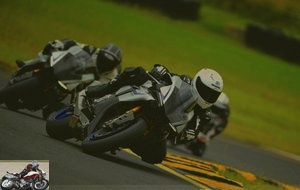
Conclusion
Yamaha has successfully returned to the hypersport segment in the most beautiful way: ultra-efficient, healthy and surprisingly easy to drive thanks in particular to its bluffing efficiency driving aids, this new Yamaha R1 will hurt competition. It remains to be seen how this radicalized 2015 vintage will fare on the road. Available in dealerships from March, the standard R1 is exchanged for 18,499 €, a competitive price takes into account its technological content which places it between a BMW S 1000 RR (17,450 €) and a Ducati Panigale 1299 (20 € 990). As for the top-of-the-range M version, even more desirable, its price is 22,499 €, but the hundred or so copies allocated to the French market have already been entirely sold. We will therefore have to wait until next year to get our hands on it. Those who have already signed their order form will be entitled to a VIP treatment from Yamaha based on track trips (1 and a half days of driving) on 4 prestigious circuits supervised by professional instructors, Yamaha technicians to help them tune their machine with the little onions, all in the presence of official pilots of the brand.
Strong points
- perfect ergonomics for small riders…
- Crossplane performance and character
- cycle part efficiency
- qualities of electronic aids
- disconcerting ease of driving
Weak points
- …much less for adults !
- perfectible braking
- readability of the instrument panel (Road mode)
Yamaha YZF R1 and R1M technical sheets
Related articles
-
Comparison test of the Yamaha YZF-R1 and R1M
The easy missile Euro5, 4 cylinders 998 cm3, 200 hp and 113.3 Nm, 201 kg full made, from € 19,299 Each brand has its legendary hyper-sport, its…
-
200 hp at 13,500 rpm, 112 N.m at 11,500 rpm, 199 kilos with full fuel, from € 18,499 Is the Crossplane engine an advantage in road use ? Even if the…
-
A tri-wheeler called pleasure Three cylinders, 4T, 84.6 kW (115.0 hp), 87.5 N.m (8.9 m.kgf), 263 kg, 14,999 euros With the arrival in 2006 of the MP3…
-
Ultimate. Phrase taken from Latin: Highest degree, unsurpassable, which is best… Insane, incredible, breathtaking … There are no qualifiers to…
-
The MT-09 gets traction control and revised engine maps A new Night Fluo color for this turbulent roadster, from € 8,499 For many years, the mid-size…
-
Yamaha Xmax 300 Iron Max scooter test
Unlimited version of the tuning fork maxiscoot Leather, seat with backrest, aluminum footrest, specific color… A scooter is always worth less than the…
-
3 cylinders, 847 cm3, 115 hp, 8.9 m / kg, 195 kilos, € 12,599 A limited series of 695 pieces in collaboration with Abarth October 2007: Valentino Rossi…
-
Backpacker at heart Twin-cylinder CP2 of 689 cm3, 74 hp and 68 Nm, 204 kg full made, 9,699 euros Stopped at the end of 2016 due to Euro 4 standards, the…
-
Yamaha VMax 1700 motorcycle test
The return of a legend The return of the good, the bad and the tonic-truante. Certain celestial objects cross our orbit according to a periodicity which…
-
Yamaha RZV 500R motorcycle test
GP 500 2 stroke … road ! 50 ° V4, 494 cc, 100 hp, 134 kg Sports bikers are familiar with the Yamaha RD 500 LC, inspired by Kenny Roberts’ YZR500….